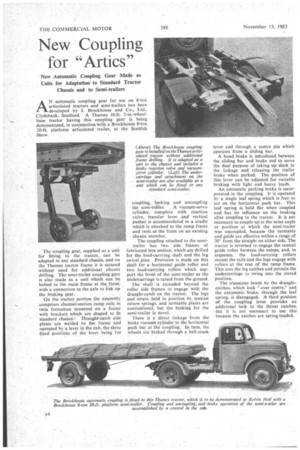New Coupling for "Artics"
Page 86

If you've noticed an error in this article please click here to report it so we can fix it.
New Automatic Coupling Gear Made as Units for Adaptation' to Standard Tractor Chassis and to Semi-trailers AN automatic coupling gear for use on 8-ton articulated tractors and semi-trailers has been developed by J. Brockhouse and Co., Ltd., Clydebank, Scotland. A Thames 10-ft, 2-in-wheel
base tractor having this coupling gear is being demonstrated, in conjunction with a Brockhouse 8-ton 20-ft. platform articulated trailer, at the Scottish Show
The coupling gear, supplied as a unit for fitting to• the tractor,: can be adapted to any standard chassis, and on the Thames tractor frame it is secured without need for additional chassis drilling. The semi-trailer coupling gear is also made as a unit which can be bolted to the main frame at the front, with a connection to the axle to link. up
the braking gear. • On the tractor portion the assembly comprises channel-section ramp rails in twin formation mounted on a frame with brackets which are shaped to fit standard chaSsiS.4 Draught-catch side plates are welded to the frame and operated by 's lever in the cab, the three fixed positions of the lever being for coupling, locking and uncoupling
the semi-trailer. A vacuum-servo cylinder, complete with reaction valve, transfer lever and vertical pusher. is accommodated in a cradle which is attached to the ramp frame and rests at the front on an existing chassis member.
The coupling attached to the semitrailer has two side frames of fabricated box section, which are drilled for the load-carrying shaft and the leg swivel pins. Provision is made on this shaft for a horizontal guide roller and two load-carrying rollers which support the front of the semi-trailer as the undercarriage is raised from the ground.
The shaft is extended beyond the roller side frames to engage with the draught-catch on the tractor. The legs and struts, held in position by tension return springs, and turntable plates are conventional, but the braking for the semi-trailer is novel.
There is a direct linkage from the brake vacuum cylinder to the horizontal push bar at the coupling. In turn, the wheels are braked through a bell-crank
lever and through a centre pin which operates from a sliding bar.
A hand brake is introduced between the sliding bar and brake rod to serve the dual purpose of taking up slack in the linkage and releasing the trailer brake when parked. The position of this lever can be adjusted for variable braking with light and heavy loads.
An automatic parking brake is incorporated in the coupling. It is operated by a single leaf spring which is free to act on the horizontal push bar. This leaf spring is held flat when coupled and has no influence on the braking after coupling to the tractor. It is not necessary to couple up at the same angle or position at which the semi-trailer was uncoupled, because the turntable and guide are effective within a range of 30 from the straight on either side. The tractor is reversed to engage the central guide roller between the ramps, and, in sequence, the load-carrying rollers mount the rails and the legs engage with rollers at the rear of the ramp frame. This arcs the leg catches and permits the undercarriage to swing into the stored position.
The trunnions brush by the draughtcatches, which lock "over centre," and the automatic brake, through the leaf spring, is disengaged. A third position of the coupling lever provides an additional lock to the throat catches, but it is not necessary to use this because the catches are spring-loaded,












































































































































































































































